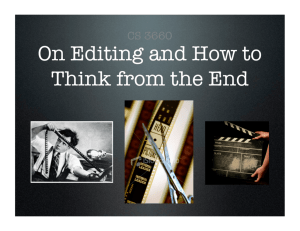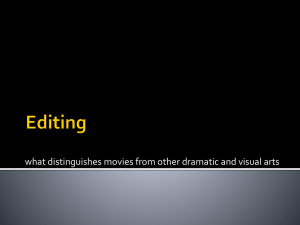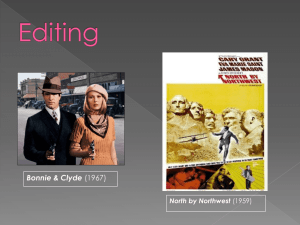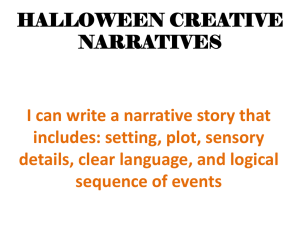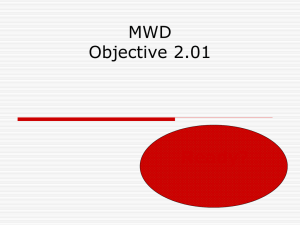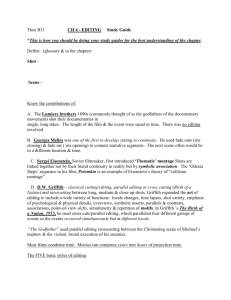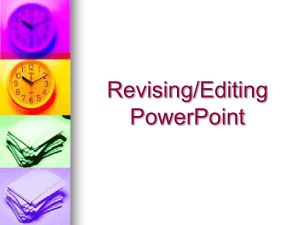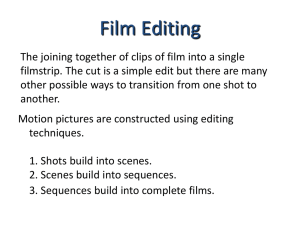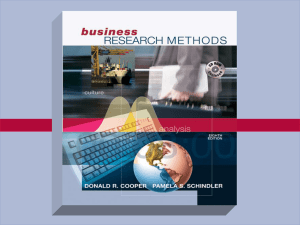ppt
advertisement
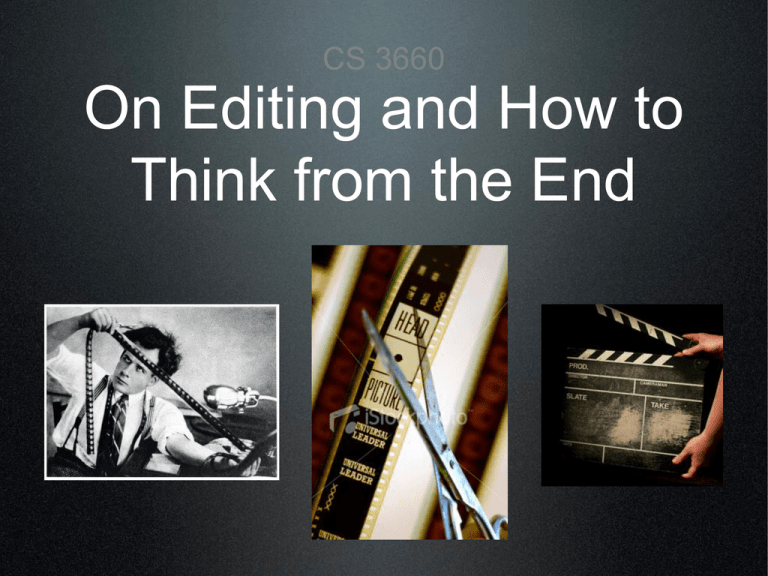
CS 3660 On Editing and How to Think from the End Thinking from the End • What you do now in pre-production and production affects what you have later in post • Shoot as though you’re going to edit • Map it out now to make it work later A Brief History of Editing • One scene, one shot--Lumiere Bros. 60 sec. camera • Multiple scenes, multiples shots--George Melies “Trip to the Moon” continuous in time (like theater) • Simultaneous events--Porter’s “The Great Train Robbery” • Parallel editing--D.W. Griffith’s “The Birth of a Nation”; 1st feature Where Does Meaning Come From? Dziga Vertov’s “Man with the Movie Camera” “This experimental work aims at creating a truly international absolute language of cinema based on its total separation from the language of theater and literature.” --opening titles Russian Montage and the Kuleshov Effect • Kuleshov edited a short film in which shots of an expressionless face of an actor were alternated with various other shots (a plate of soup, a girl, an old woman’s coffin) • The film was shown to an audience who believed that the expression on the actor’s face was different each time he appeared, depending on whether he was “looking at” the plate of soup, the girl, or the coffin--showing an expression of hunger, desire, or grief respectively Juxtaposition • Kuleshov experiment, Hegelian dialectic, and the 3rd effect • Thesis + Antithesis = Synthesis • A+B=X • Ex. Image of man + Image of bread = Hunger Continuous Juxtaposition Example--“WALL-E” The standard Hollywood movie today has 5000 cuts. --Walter Murch The average shot length (ASL) for U.S. films released in 2007 was 2.5 seconds. Three Editing Philosophies 1.) Continuity Editing • The traditional Hollywood approach to editing that attempts to smooth over the inherent discontinuity of the editing process and to establish a logical coherence between shots • Also called invisible editing Three Editing Philosophies 2.) Montage Editing • Not concerned with the depiction of a comprehensible spatial or temporal continuity • The cuts between shots are more obvious, less fluid, and non-seamless • Meaning built by the juxtaposition of shots Three Editing Philosophies • 3.) Realism or Mise-enScene • Few edits (long takes) with emphasis on composition and camera movement • Is it really realistic? No, we just call it that because Andre Bazin did. Examples Montage vs Mise-en-Scene Types of Cuts 1.) MATCH ON ACTION • An edit where two views of the same action are cut together at a point during the action • Commonly used technique in continuity editing, especially in scenes with lots of action Types of Cuts 2.) JUMP CUT • An edit where there is a moment of discontinuity in an action • A piece of the action is missing • Abrupt jump from one similar shot to another Types of Cuts 3.) CROSS CUT or PARALLEL CUT • An edit where there are two or more actions taking place then cutting back and forth between them • Usually involves two separate scenes--may be happening simultaneously Types of Cuts 4.) GRAPHIC MATCH, or MATCH CUT • A cut between two shots that have similar compositions, but different subjects Types of Cuts 5.) “MAGIC EDITS” • Flash/swish pan • Actors block camera • Object wipe • Fade on camera Transitions • Fade In/Fade Out--Transitions where picture eases in from , or out to black • Dissolves--Transitions where two pictures blend into each other for the length of the transition • Wipe--Transitions where one image in some way pushes the other out of the frame. • Irising, Blocking, Masking, CGI-Variations on fades, wipes, and dissolves Example Layer Cake (2004) Editing Dialogue & the Master Shot Technique • Shooting the entire scene from a wide shot and then shooting progressively closer shots to cut in later • Better for editing but less precise than knowing what you want to shoot and just shooting it Editing Rules 1.) 180° RULE • The camera must stay on one side of the actors so that they appear in opposite sides of the frame (because 2D space) • “Crossing the line” causes disorientation • http://www.youtube.com/watch?v= HdyyuqmCW14 • Reason to break rule? Creates confusion/action Editing Rules 2.) CHANGE SHOT SIZE/CHANGE ANGLE • Substantial change in angle of camera or view allows for matching action edit; avoids jump cut • Also known as 30° rule Editing Rules 3.) SHOT/REVERSE SHOT • Similar shot sizes complementing each other from one angle and then the opposite or reverse angle • Exchanges glances and often used for dialogue • Note similar composition and eye-line match Editing Rules 4.) CLEAN ENTRANCES/EXITS • Let subject completely enter and/or exit the frame • Once subject out of frame, they can be anywhere • When entering, they can enter from anywhere Long Takes & Mise-enscene Sequences • One continuous shot that holds all the action within the frame Lessons from Cover Pacing • Generally • More action, more shots • Less action, fewer shots • Know when to hold Examples “Spy Game” and “Making Things Explode Trailer”http://www.youtube.com/uumachinima “A Day in the Life of a Turret” “The Dumb Man” “Gift Horse” http://z-studios.com/films/gift-horse/ “Ignis Solus” “Male Restroom Etiquette” More Info • “The Bare Bones Camera Course for Film and Video” by Tom Schroeppel • http://classes.yale.edu/film-analysis/ and click on “Editing” on left side bar
